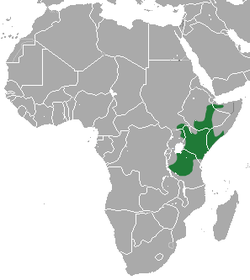Ecology, diet, and behavior
Rufous elephant shrews are active throughout the day, with peaks in activity at dusk and dawn while having a midday rest. A mating male and female will build trails beneath leaf litter. The trails act as shelter and protection because the rufous elephant shrew does not build or use shelters or burrows. Throughout the trails are several rest spots for scent-marking and sunbathing. [8] Moving the forefoot laterally to push aside leaf litter and other loose debris, G. rufescens constructs and maintains trails. [9] The males usually spend most of their time cleaning the foraging trails. Except for foraging, all activities are performed in these trails. Trails act as an important means for escaping from predators. Insects form the major food resource of their diet in the dry season, while seeds are consumed during periods of rain. [5]
G. rufescens has not been observed sleeping with closed eyes, but has been observed resting with eyes partially closed for a period of 1 – 2 minutes. During these rest periods, which occur in rest spot along the trails, G. rufescens keeps their feet under their body to allow for a quick escape. This species takes flight when even the smallest noise is heard. [10]
This species is fairly monogamous; however, members of a monogamous pair spend little time together and are limited in social interaction. They live in a matriarchal society in which the female of the pair usually dominates the male. [11]
The rufous elephant shrew gives birth to one or two precocial young per litter. The female gives birth at the base of bushes or by fallen tree limbs beside the trails. She does not stay will the neonates and only nurses them in infrequently and for only a short amount of time. The neonates remain in the parental trails, expanding their familiarity of the parental territory up to 14 days after birth. If the young wander into any neighboring rufous elephant shrew trails, the residing residents chase them out of their trails. Before the next litter is born, parents chase the previous litter for the trails resulting in dispersal or death of the previous litter. [8]
Olfactory communication between young G. rufescens and their parents is achieved through apocrine glands (pedal glands) located on the underside of the young's feet. Neonates less than five days old have been observed back-rubbing one of its parents. Parents crouch down, allowing the neonates to climb on their backs and vigorously rub their four feet in the fur in a rapid vibrating motion. Cooperation between the neonates and adults is necessary or the neonates will fall off. The act of back-rubbing allows neonates to deposit pedal gland products on the fur of the parents and in turn transfer parental odors to their own fur. The mixture of the scents creates a family odor that can be used for recognizing family members. [8]
This page is based on this
Wikipedia article Text is available under the
CC BY-SA 4.0 license; additional terms may apply.
Images, videos and audio are available under their respective licenses.


